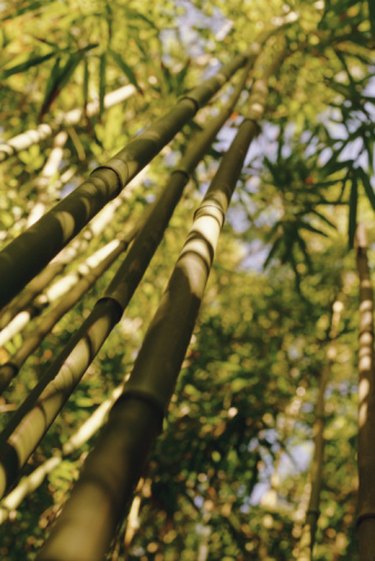Things You'll Need
Bamboo plants
Loam or marley soil
Nitrogen-rich lawn fertilizer
Organic mulch
Water

Bamboo grows best in tropical and temperate climates. When growing bamboo is Wisconsin, it is best to plant it during the summer and spring months for the best chance of survival. In good conditions, bamboo can grow up to 3 inches a day. Growing bamboo can be more challenging than growing other plants because placement, soil and climate are important factors to consider. However, bamboo is relatively inexpensive and can add a beautiful decorative element to your garden.
Placement
Step 1
Research the type of bamboo you are interested in growing to make sure that it can thrive in Wisconsin's climate. Go to your local garden store and talk to a representative about what type of bamboo you want to grow and what area you are interested in growing it in. Species of bamboo that can grow in Wisconsin include Snow Bamboo, Canebrake Bamboo and Dwarf Variegated Bamboo.
Video of the Day
Step 2
Choose an area to grow your bamboo. Bamboo grows best in areas of direct sunlight, so it is important to select a growing area that gets ample sunlight during the summer and spring months.
Step 3
Select a loam or marley soil in which to plant your bamboo. Bamboo does best in moderately acidic soil.
Planting and Watering
Step 1
Dig a hole in the area selected to plant the bamboo. The hole should be about the same depth as the container the bamboo came from the nursery in and about twice as wide. Planting the bamboo too deep can keep the bamboo from getting proper nutrients.
Step 2
Create a soil mixture of one part organic compost and one part soil. Place this mixture into the hole, focusing on filling the bottom and outer walls of the hole. You want to leave enough room for the bamboo stalk itself.
Step 3
Place the bamboo stalk in the hole and fill in the space around the plant with the soil/compost mixture. Be careful to avoid leaving air pockets around the roots of the plant.
Step 4
Water the newly planted bamboo generously and firmly pack the soil once it is wet. After the first watering, the bamboo should be watered about two to five times per week to ensure optimal growth. Bamboo needs to be watered more often in warmer climates.
Step 5
Place a layer of mulch around the roots and rhizomes to protect the plant. Compost and dried leaves make the best mulch for bamboo.
Maintenance
Video of the Day
Step 1
Add a 2-inch layer of fertilizer to the soil around the shoots once the bamboo is established. The best fertilizer for bamboo is an organic fertilizer that is high in nitrogen.
Step 2
Cut away the older bamboo stalks from the bamboo area. Bamboo does not need to be pruned regularly after planting, but the older stalks can start to dry out and can be cut away when necessary. This is more for aesthetic purposes than anything, but this practice can also aid in the healthy growth of new stalks.
Step 3
Protect the bamboo from frost and ice. Because Wisconsin has extreme cold weather in the winter months, it is important to add a thick layer of mulch to the bottom of the stalks.
Step 4
Plant a hearty, cold-weather plant around the bamboo area. This plant will absorb much of the wind and help the bamboo stay healthy during the winter months. You can also install a panel or screen around the bamboo to protect it from cold winds.
Step 5
Dig a trench around the bamboo area if spreading becomes a problem. Bamboo has a shallow root system, so the trench does not need to be very deep, about 3-4 inches should be enough to keep the bamboo contained.